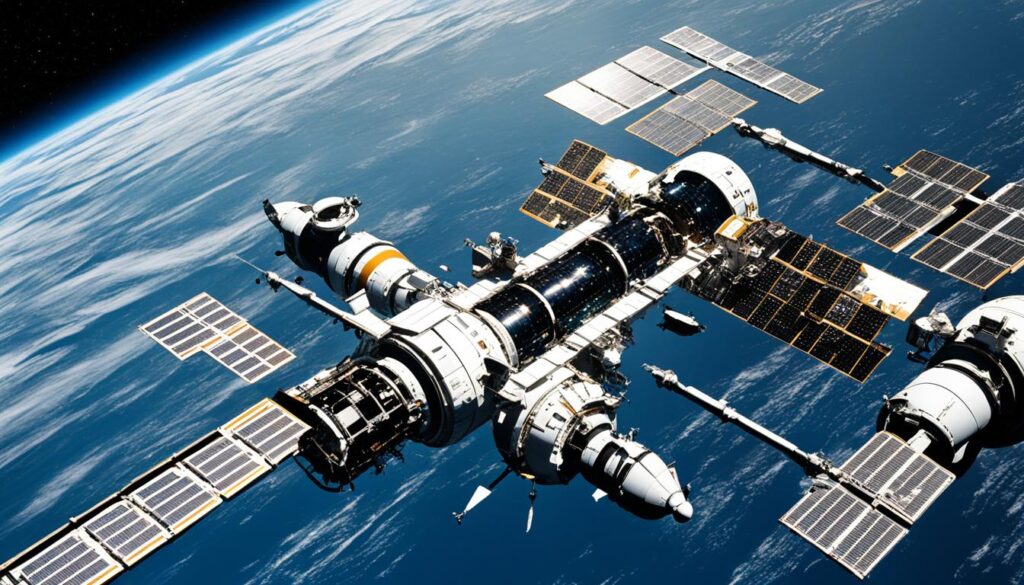“As an Amazon Associate I earn from qualifying purchases.” .
In our fast-moving workplaces, boosting productivity and innovation is key. That’s why space activity management is so important now. In the world of spacecraft operations and mission planning, using space resources wisely is vital.
Think about every inch of your workspace being used perfectly. This is what space activity management aims for. It brings together physical and digital worlds for better space traffic and satellite management. Plus, it tackles the problem of space debris.
Key Takeaways
- Space activity management optimizes workspace utilization, contributing to productivity and cost savings.
- It encompasses critical aspects like spacecraft operations, mission planning, and space situational awareness.
- Space logistics, traffic management, and satellite constellation coordination are integral components.
- Effective space debris mitigation strategies ensure the sustainability of space operations.
- Advanced software solutions offer features like occupancy tracking, room booking, and interactive maps.
What is Space Activity Management?
Space Activity Management means using office spaces well for the best results. It focuses on creating workspaces that help employees work better. This includes making sure common areas are safe, comfortable, and have what people need.
Optimizing Physical Space Utilization
A study found that many offices are not used efficiently. For example, spaces meant for many people might only have a few. Making the best use of space helps save resources and avoids waste.
Importance of Effective Space Planning
Planning space well helps people work better and saves money. For instance, a vacant conference room costs a lot each year, but it’s seldom used. This shows the importance of managing space well.
Benefits of Space Management Software
Space management solutions help make the most of office space. They can make work smoother, reduce mess, and improve how people work together. These tools also give you a close look at how space is used and help plan better, cutting down on costs and making work a nicer place to be.
| Objective | Description |
|---|---|
| Understand Space Usage | Gain insights into how physical spaces are being utilized. |
| Access Real-Time Data | Leverage real-time data for informed decision-making. |
| Ensure Efficient Space Use | Optimize space allocation to reduce operational costs. |
| Create Pleasant Environment | Foster a collaborative and productive work environment to attract and retain talent. |
Firms use workplace management software to check how space is used, see who’s where, keep spaces well, and plan for the future. These programs help make the most of space, boost how well people work, save money, build a strong work culture, and make it easy to do business in a changing world.
Key Features of Space Management Solutions
Modern space management features help use resources better and boost work productivity. They let organizations use data to streamline managing their spaces.
Interactive Maps and Resource Visualization
Space management solutions offer interactive maps and visualizations. These show all available spaces, resources, and assets. Via maps, users easily see and plan how to best use workspaces and meeting rooms.

Occupancy Tracking and Space Utilization Data
Accurate occupancy tracking and utilization data are vital. Solutions use sensors and analytics. This lets organizations know how their spaces are used, pointing out areas not used enough.
With real-time occupancy data, organizations make better use of their spaces. And they plan better for the future.
Room and Desk Booking Systems
Booking workspaces smoothly is important for space management. Systems for booking rooms and desks make it simple for employees to reserve what they need. This boosts resource utilization and collaboration.
These systems sync with maps and calendars. They ensure booking is easy and prevent conflicts over space.
Using these features, organizations can improve their spaces, boost productivity, and cut costs. They help businesses make smart decisions and set up workspaces where innovation and collaboration thrive.
Space Activity Management
In the world of space, managing activities is key for success and using resources well. It covers many important areas like Spacecraft Operations, Mission Planning, Orbital Trajectory Analysis, and Space Situational Awareness.
Spacecraft Operations Management
Managing Spacecraft Operations is vital for mission success. It involves checking and controlling spacecraft systems to make sure they’re working well. Mission control centers lead this work, using advanced tools and skilled people to ensure everything goes smoothly.
Mission Planning and Orbital Trajectory Analysis
Mission Planning and Orbital Trajectory Analysis are crucial parts of running space activities. This means carefully planning the best paths for spacecraft to travel, considering fuel, space conditions, and the things they carry. This planning helps to use resources wisely and get spacecraft to their goals safely and on time.
Space Situational Awareness
Space Situational Awareness is about keeping track of things in space. It looks for things that could crash and ways to avoid dangerous space junk. This work helps keep our space activities safe and allows us to use space for a long time.
Coordination is crucial to success. It means different groups working together, like space agencies, companies, and research centers. This helps everyone learn from each other and share important information for better space activities.
Space Logistics and Traffic Management
The space industry is growing fast. Therefore, managing space logistics and traffic is crucial. It is essential due to the large number of satellites and spacecraft in space. This helps in maintaining a safe orbital environment.
Satellite Constellation Management
Satellite constellations, especially in low Earth orbit, need careful management. Companies like SpaceX and Amazon deploy satellites for global internet. Meanwhile, others use them for Earth observation and communication.
To manage satellite constellations, detailed planning and monitoring are necessary. This ensures smooth operations while preventing collisions. It involves careful orbital insertion, station-keeping, and proper disposal of satellites.

Space Debris Mitigation Strategies
The increasing number of objects in space raises the risk of collisions with debris. Therefore, it’s crucial to have strategies to protect space assets. This is vital for the future of space activities.
Strategies include removing debris from space and designing spacecraft to reduce debris. Also, better tracking and monitoring are important. Organizations like the IADC and the ESA work on these issues. They create guidelines and implement measures to reduce space debris.
| Region | Market Share | Growth Rate |
|---|---|---|
| North America | 43% | 15.2% |
| Europe | 27% | 18.5% |
| Asia Pacific | 19% | 21.7% |
| Rest of the World | 11% | 16.8% |
The table shows North America leads in the space logistics market. It also reveals rapid growth expected in the Asia Pacific region.
The space industry will keep growing. We need better space logistics and traffic control. These improvements will support safe and sustainable space exploration.
Enhancing Employee Productivity and Experience
In today’s work settings, making the most of workspace and teamwork is key. This boosts employee productivity and how they feel about work. With the right tools, like space design, companies can form an atmosphere that supports working together better.
Optimized Workspace Layout
Great workspace optimization means setting up offices well. This cuts down on things that might get in the way and makes work smoother. A good layout helps people talk easily, controls noise, and separates quiet from busy work areas.
Research by Density found that many offices are only used a quarter of what they could be. Making better use of the space can spike up how much work gets done. It’s about using where we work smarter, not harder.
Flexible and Collaborative Environments
Places made for group work help teams connect and share ideas. They use open areas, rooms for small meetings, and spots for team discussions. These spaces are set up to get people talking and create new ideas together. It makes working together a piece of cake and helps the whole company succeed.
Gensler’s research reveals that 83% of employees would return to the office one additional day per month if the office provided their ideal mix of work-related and social experiences.
Improved Safety and Well-being
Taking care of workplace safety and employee well-being is a must for a place people want to work in. Using space smartly helps companies follow rules on safety and make sure the place is comfy and secure for everyone.
Projects like Wellbuilt for Wellbeing prove that how we set up workspaces really affects people’s work. When companies listen to what their workers need in their working space, it helps keep everyone happy and working hard. This way, people miss work less and feel good about their job, lifting how much work they get done.
Cost Savings and Resource Optimization
Good space management helps lower costs and use resources better. Businesses are finding that using their office space right is key. This meets the needs of a changing workforce and lower space needs.
Reducing Real Estate Expenditures
Managing space well can cut real estate optimization costs. By looking at how space is used, companies can see where they can do better. They can then cut space or share it. This cuts rent and lowers other costs too.
Industry reports show that 75% of companies plan to cut office space in 2024. This shows a big move to save money by using space better.

Efficient Utilization of Office Resources
Good space management helps companies use their office resources better. Tools like booking systems for rooms and desks help. They make sure all places are used well, cutting waste.
Companies also use these tools to meet changing workforce needs. They work well for teams that work remotely or in the office. This makes things run smoother and cheaper by avoiding waste and using things well.
86% of respondents in a Forrester survey feel it’s important or extremely important to utilize space management data more effectively in their organizations.
Companies can save money and make a greener office by using space data. They can adjust layouts and share space more. This creates a better, more eco-friendly place to work.
Data-Driven Space Management Strategies
Today, data analytics are key for making the best use of space at work. They help improve how areas are used and make our jobs better. Space management that’s data-focused lets companies work smarter, do more, and run well.
Utilization Analytics and Reporting
Space tools use utilization analytics and reporting to see how rooms are used. They figure out where we cram in too much or which spots stay empty. This data guides us on changing things for the better. It helps find the right mix of efficiency and what workers really need.
Identifying Trends and Optimizing Layouts
Good space tools look deeper to spot trends in how we use rooms. They let us see what we’re likely to need next and help us get ready. By keeping an eye on the data, businesses can choose smart ways to boost how well we work together and use our space.
With this tech, big companies can avoid expanding on space they don’t need. Instead, they can use what they have better. Those with teams both at home and in the office can set up their spaces based on what matters most to their workers. This can make a huge difference in how happy people are with their jobs.
| Space Management Metric | Description | Optimization Potential |
|---|---|---|
| Density | Ratio of people to available space | Balance occupancy and space allocation |
| Usage Rate | Frequency and duration of space utilization | Identify underutilized or overcrowded areas |
| Space Allocation | Assigned space for specific activities or teams | Optimize layouts for efficient workflow |
With data-driven space management, companies can get more from their space. It helps boost how we work together, creating better work environments and improving operations.
Adapting to Hybrid and Flexible Work Models
The workplace has seen big changes with the rise of hybrid and flexible models. Today, 8 out of 10 workers have moved to hybrid or remote work. Space management is now key for businesses to handle these shifts well.
Managing Remote and On-site Workforce
Now, handling a mix of local and remote work is a key task. Space management tools help workers come together smoothly, no matter where they are. They make it easy to talk, work on projects, and share information.
Right-sizing Office Spaces
Shifting to hybrid and flexible models lets companies use their office space better. They can cut down on areas not often used, saving money. This means they can make the office better for those who do come in. It’s all about doing more with less.
In Europe, 30% of companies are already using a hybrid model, as shown by Eurostat. 98% of workers want the option to work offsite at times. This shows the growing need for flexible work.
Companies are choosing different ways to do hybrid work. Some, like Google, set specific days for when to be in the office. Others, like Spotify, let employees pick where they work.
The fixed hybrid model brings stability, helps with teamwork, and balances life better. But, it might lack flexibility and cause problems with the office. Everyone might not find it welcoming.
The flexible model offers independence and better life-work balance. It can also attract and keep top talent. However, managing it can be tough, leading to less clear communication and issues with technology safety.
| Hybrid Work Model | Advantages | Disadvantages |
|---|---|---|
| Fixed |
|
|
| Flexible |
|
|
Space Resource Utilization
Space management solutions make using office resources simple. They ensure workspaces are used well, boosting work quality. It’s key to blend meeting room reservations and desk booking for employee flexibility.
Meeting Room and Desk Booking
These systems let users easily book meeting rooms or desks. This prevents two people from reserving the same space. And with instant access to what’s free, employees quickly find the best spot for their activity.
Visitor and Employee Management
Visitor tracking and managing workers are vital for safety and order. Space management tools help keep track of who’s where. They also make sure spaces are used safely. This info is useful for smarter resource use.
Space Reservation and Scheduling
These tools cover more than just meeting rooms and desks. They help schedule many shared areas. Smart scheduling keeps things running smoothly. Everyone can grab a spot, which boosts teamwork and maxes out every space.
A strategic approach to space management can boost space efficiency, improve workforce productivity, minimize vacant space, save operational costs, and ensure compliance.
Thanks to these tools, companies can run smoother, please their workers, and smartly manage their spaces. This leads to better utilization, making the most of every space for top-notch creativity and work.
Integration with Workplace Management Systems
Combining space management with broader workplace management systems helps organizations work better. It improves how they use their space and boosts overall efficiency. This setup means that all workspaces are taken care of well, from maintenance to security.
Facilities Management Integration
When space management is tied to facilities systems, several things work better. Maintenance, equipment tracking, and service requests are easier to handle. This makes sure that workspaces are always safe and ready for use. It’s a big win for everyone who works in those places.
Internet of Things (IoT) and Sensor Integration
Bringing in IoT and sensors to manage space gives live info on how spaces are used. This includes data on who’s there, the environment, and where assets are. With this data, spaces can be used smarter. It saves energy and improves how resources are used. This tech helps organizations perform better by making smarter choices, which saves money and makes the workspace better for all.
FAQ
What is Space Activity Management?
What are the key features of space management solutions?
What aspects are included in Space Activity Management?
How does effective space management enhance employee productivity and experience?
What are the cost savings and resource optimization benefits of space management solutions?
How do space management solutions support data-driven strategies?
How do space management solutions adapt to hybrid and flexible work models?
What space resource utilization features do space management solutions offer?
How do space management solutions integrate with broader workplace management systems?
“As an Amazon Associate I earn from qualifying purchases.” .



